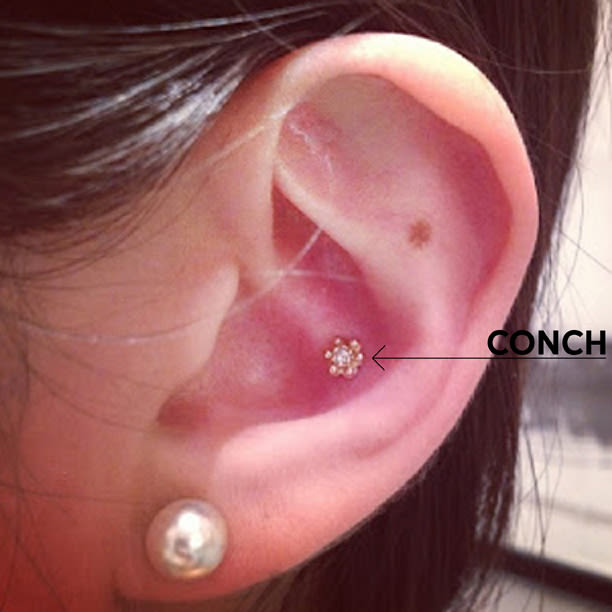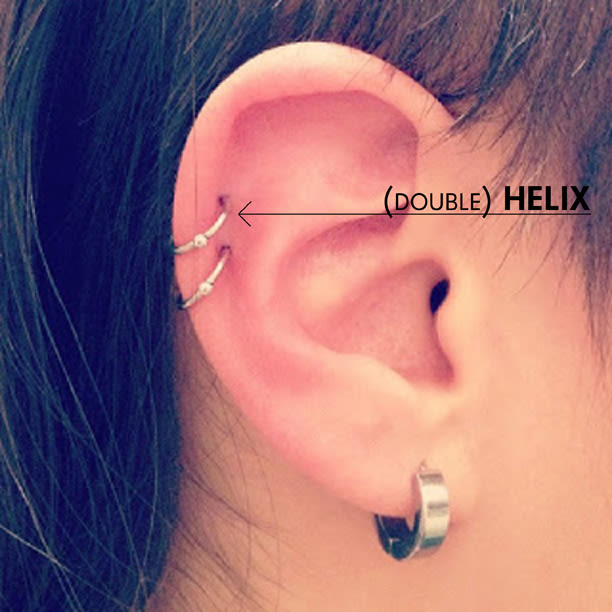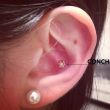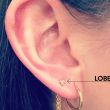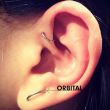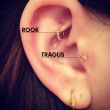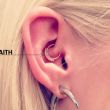As far as body modification goes, team ITG favors piercing. A tattoo can, as one friend put it, too often be referred to as a “permanent 'oops.'' But getting a new piercing is as easy, thrilling, and seasonal as picking up a new pair of heels. And while it's been around for ages, there's been a definite shift as of late: piercing seems to have come fully out of the proverbial closet (where it lived for awhile as an underground, rebellious punk-tinged and angst-ridden I hate my parents move) and onto magazine covers and fashion’s runways and into its own as an art form, with the best of them (the delicate, graceful, face-flattering iterations we tend to favor) rising to the top. Don’t believe us? Check out January’s issue of Vogue UK, or Givenchy’s nose rings from Spring 2012, or the elegant versions on runway regulars like Guinevere Van Seenus, Catherine McNeil, Behati, or Abbey Lee.
So, craving a little extra bling? We always refer our friends to the man with his finger on the pulse and a needle semi-regularly in our ears, J. Colby Smith, whose soothing energy is a near-narcotic and whose eye for balance and harmony when it comes to piercings is pretty much tops. New York Adorned's resident piercer offered some words of wisdom on the topic (that’d be how, what, and, most importantly, where to punch those holes) and handed over examples of his handiwork. Who'd have thought an ear had so many parts? If you're considering joining the ranks of the subtly, beautifully adorned, print out a snap and take it your next appointment, though don’t forget to keep an open mind. Everyone’s ears are different, as Smith emphasizes, and you should be open to what looks best on you, not just what you think you want.
Your ear is a snowflake: “A lot of the time people will come in having seen a piercing on somebody else and they want that exact thing, that exact piercing. It’s better if I can survey an ear and say, 'This works, this works, this’ll work.' Everyone’s ear is totally different. One thing works for you, it won’t necessarily work for her. I spend the majority of my day battling with people about that. Almost every day of my life there’s a heartbreak because someone comes in with an idea of exactly what they want and it won’t work. It’s weird, but it always seems like what's not possible is exactly what people want.”
Be open-minded: “Piercers are really just assistants to help people get what they want, so it doesn’t matter as much if they know the exact name of the location they want pierced, but the more they know, the easier it is to get them what they want. To me, piercing is not 'go to a store, look at a display case, pick out jewelry, get it put in.' To me, it’s more of a conversation, like, 'These are the things I like, I wear this type of jewelry, I don’t know what works for me, let’s figure it out.' I normally check out what other jewelry they’re wearing, see what their style is overall, and what will be a good fit for them. It’s really hard to go look at a jewelry case and understand what works and what doesn’t work on your own head. I really do believe it’s more of a conversation, that you shouldn’t go in set on something.”
Where on my ear can I pierce?: “I can technically pierce anything that I can fit jewelry into. You can pierce through your conch, your [rook](http://en.wikipedia.org/wiki/Rook_(piercing “ target=), your daith, around the middle here [under the helix]. All over the lobe, that’s the most standard, the most basic. Then, you can get into some crazy stuff that I don’t like to do because, without fail, it’s going to be a problem, because parts of the ear can be very thick. This stuff [indicates earlobe and helix] generally works pretty well with everyone; everything else is on the iffy side, because the cartilidge is thicker, it might take longer to heal, and it might get irritated.”
What can I get where? or, How does piercing jewelry work?: “ Certain jewelry works with certain piercings. For an earlobe, you can have a stud or a ring—I think people don’t understand what goes where. There’s three separate parts to any piercing jewelry. There’s a front ball, the hollow post, and the backing, which can be another ball. Some jewelry can stay in forever, like the kind we use for most rook or daith piercings, but it’s like any piece of jewelry, you can change it if you get tired of it. I try to lean towards the classic stuff, you know, the stuff that if you look back in 10 years you’re not going to be like 'Oh god, what was I thinking?!' [Laughs] I always talk about the jewelry as shapes, but they have real names: there's a flat-backed barbell, a curved bar, a captive bead ring, a barbell, a seamless ring, a circular barbel. There are fancier versions, but they’re all based off these shapes. Anywhere you go they’ll know those names.” [Ed.: Even a mall-based Piercing Pagoda?] “Yep.”
On needles versus piercing guns: “I had my ears pierced in the mid ‘90s in the mall with a gun. I had a girlfriend who worked at Claire’s, she was terrified to do it on people, so she would practice on me. She did my ears, my eyebrow. [Laughs] And they still use the gun, it’s fine—they’ve been using it for a hundred years, nobody’s ever really died from it—but the main difference with what we do [with needles] is that it’s a little more sterile, and we can be a lot more precise with it. With a gun, you can see the general area but you can’t be very precise with it. With a needle, you end up with a cleaner piercing, and altogether it’s better. With a gun, you’re forcing the earring through the skin with pressure, so there's the potential to make a real mess.”
Is it true that a mis-handled piercing can cause facial paralysis?: “A lot of people believe that you can get paralyzed from a bad piercing, but I’ve never heard of that really happening. I think it’s kind of a myth—but at the same time, I believe in acupuncture and acupressure and I believe that there are certain points on the body that can probably stimulate things you want, or things you don’t want. I’ve actually pierced multiple acupuncture therapists and it seems like there’s two theories on it: one will say the energy will re-route itself and it’s not a big deal, and the others will say it won’t and it’s the worst thing in the world. The first group come in specifically to get something pierced to stimulate a certain whatever.”
Patience is a virtue: “The biggest thing—the most important thing—is patience. Piercings are not perfect right away, they’re not guaranteed 100% of the time. It’s a weird thing, sometimes some people, they get pierced, they never think about it, they clean it a little bit, and it’s fine. Other people, they struggle and struggle and struggle with it. Generally, with irritated piercings, if you soak them in salt water, it always helps. I don’t advise cleaning them too much, and how much you do clean it depends on the piercing. For most types, it's once a day, with Dr. Bronner’s baby soap lathered up and gently swooshed around it—that’s perfect. The ocean’s always good for healing a piercing, too. Healing everything: mind, body and spirit.” [Ed.: Mental note—move to a city where that’s possible.]
Much respect: “One thing that can be difficult is people not understanding exactly what it’s like to be in my position. I think a lot of people are just not mentally prepared for what they need to go through; it takes a certain level of maturity to accomplish... Of course, you can be scared or nervous: some people bring friends, some have to come alone. It’s a very minor procedure, but to some, it’s not minor, it’s one of the worst things that they’ve ever experienced in their life. And then some people don’t realize that they’ve come to us to get this thing done, but then they’re making it difficult for us to do our job, and acting like 'WHY ARE YOU DOING THIS TO ME?' as if I coaxed them in off the street!”
Can I get a piercing if I’ve been drinking, or if I'm on blood-thinning medication?: “I can tell by people’s blood if they’re on medication, if they’re taking vitamins, if they were drinking the night before, if they eat really fatty foods. Blood, visually, you can tell a lot. If they eat really fatty foods, it's thick. It’s pretty gross. With drinking and stuff, a lot of people think they can’t drink before, can’t drink after—with that, you just want people to be in a good frame of mind. You don’t want them to be making bad choices or doing something because they’re not in their right mind. I don’t mind if people have a glass of wine or a drink before they come. It won’t make them bleed more—what I do is so quick that I actually plug it up before it has a chance to bleed out. But you know, if a glass of wine helps somebody relax a little bit before I get to them? That makes it easier for them, and easier for me. But definitely, if you have any questions about medications you're on or how a piercing might affect you, call your doctor before you come in.”
Enough is enough, or ‘Balance and harmony above all': “I try to focus on the delicate, finer types of things. A big part of what I do is telling people ‘enough is enough,’ you know. Balance is important, the harmony of it. The way I think about it is that you can get these things pierced, you can add this thing, you can take that one out, you don’t always have to have everything full of jewelry all the time. Some people, sure...it works. But, a lot of people try to do everything at once. Me, I will usually only do 2 to 3 piercings at a time, and if they’re close together, I’ll only do two at at time, tops. I like the idea of people getting something pierced, letting it heal, coming back again, just kind of gradually building on it. I feel like everyone’s in such a rush to look a certain way and do this or do that and have the full results immediately. Ultimately, piercings do better if you just do each by itself; you have to be good to your body. In a sense, you’re damaging your body, so you have to let it repair itself and deal with it before you start doing it again... A lot of piercing is dealing with the after-care and it’s not exactly what people want right away, but when people come in with old holes and just want to update them with new jewelry of mine, just fill ‘em with gold, that’s the best scenario for me; I love that. And that’s actually a new trend that I’m seeing—people are coming in just to get their ears 'styled' by me and they let me just do what I want to do... it’s just so flattering.”
As for new trends?: “I will say this: Septum chains have gone out a little bit, and backdrop chains are in.”
You heard it here first, kids.
All photos provided by J. Colby Smith's on his Instagram: @jcolbysmith ,[9-10] Hedvig Palm photographed by Patrick Demarchelier for Vogue UK.
